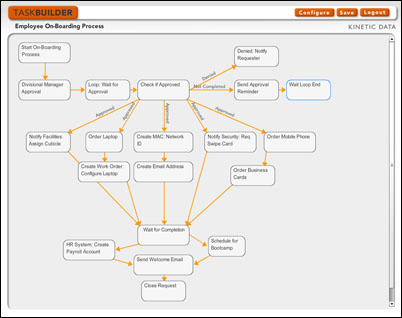When you think about business process automation (BPA), you usually think about automating mission-critical or core business processes and long and expensive development efforts. The benefits to the business usually justify all the time and money you spend, but its best to leave the details to IT experts, since they are the only ones in the enterprise with the knowledge and experience to pull off BPA.
But by making BPA such a big (and often scary) deal, businesses may overlook a relatively unexplored frontier of business process automation — automating the hundreds and often thousands of “small processes” that happen every day in a business and consume untold hours in emails, phone calls, filling out paperwork and manually entering data from one system to another. In HR, facilities management, sales and marketing, procurement, customer service, finance and other areas, a lot of work gets done in such an inefficient manner. These processes are prime candidates for automation — if only IT and business decision makers could shake off the “big” BPA mindset and look for ways to automate wherever and whenever it makes sense.
 Kinetic Task has long been an fast and efficient way to automate processes triggered within an IT service management environment such as BMC Remedy. The new release of Kinetic Task 3.0 works with virtually any application or database, which extends those benefits to virtually any part of the enterprise that can benefit from BPA. It takes advantage of the fact that most business workflow processes are started by a trigger, (record gets created) or often when a data field is updated in an application database or entries are made in a logfile. By monitoring these applications and log files, Kinetic Task can invoke predefined workflow steps, such as creating billing entries or initiating and enforcing approval processes, that result in the process being completed with little or no manual intervention.
Kinetic Task has long been an fast and efficient way to automate processes triggered within an IT service management environment such as BMC Remedy. The new release of Kinetic Task 3.0 works with virtually any application or database, which extends those benefits to virtually any part of the enterprise that can benefit from BPA. It takes advantage of the fact that most business workflow processes are started by a trigger, (record gets created) or often when a data field is updated in an application database or entries are made in a logfile. By monitoring these applications and log files, Kinetic Task can invoke predefined workflow steps, such as creating billing entries or initiating and enforcing approval processes, that result in the process being completed with little or no manual intervention.
But unlike most other BPA approaches and products, Kinetic Task can be extended to non-technical users in any department or business area. It does so by the use of two key components:
- configurable task trees, which allow non-technical users to easily define the steps in a process automation workflow; and
- a powerful task engine, which automates the execution of steps in the workflow once it is triggered by an underlying application system or database.
Call it “lightweight” BPA if you like. By taking such an holistic approach to BPA, larger enterprises can save thousands of hours a year in manual or semi-automated processing while improving the accuracy and quality of process execution.
Want to learn more? Download a free white paper on our approach to enterprise-wide holistic BPA.
